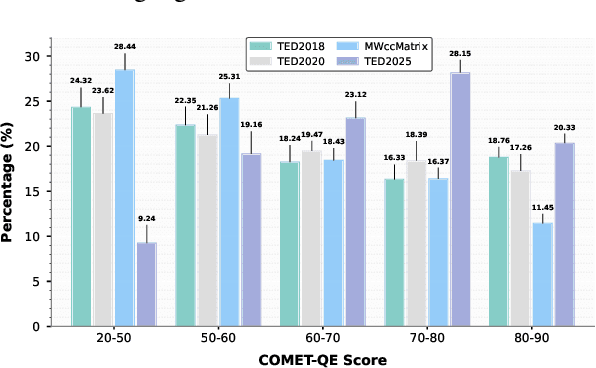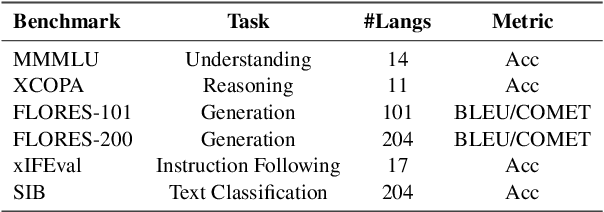Kangyang Luo
Consistent Assistant Domains Transformer for Source-free Domain Adaptation
Oct 02, 2025Abstract:Source-free domain adaptation (SFDA) aims to address the challenge of adapting to a target domain without accessing the source domain directly. However, due to the inaccessibility of source domain data, deterministic invariable features cannot be obtained. Current mainstream methods primarily focus on evaluating invariant features in the target domain that closely resemble those in the source domain, subsequently aligning the target domain with the source domain. However, these methods are susceptible to hard samples and influenced by domain bias. In this paper, we propose a Consistent Assistant Domains Transformer for SFDA, abbreviated as CADTrans, which solves the issue by constructing invariable feature representations of domain consistency. Concretely, we develop an assistant domain module for CADTrans to obtain diversified representations from the intermediate aggregated global attentions, which addresses the limitation of existing methods in adequately representing diversity. Based on assistant and target domains, invariable feature representations are obtained by multiple consistent strategies, which can be used to distinguish easy and hard samples. Finally, to align the hard samples to the corresponding easy samples, we construct a conditional multi-kernel max mean discrepancy (CMK-MMD) strategy to distinguish between samples of the same category and those of different categories. Extensive experiments are conducted on various benchmarks such as Office-31, Office-Home, VISDA-C, and DomainNet-126, proving the significant performance improvements achieved by our proposed approaches. Code is available at https://github.com/RoryShao/CADTrans.git.
Teaching Large Language Models to Maintain Contextual Faithfulness via Synthetic Tasks and Reinforcement Learning
May 22, 2025Abstract:Teaching large language models (LLMs) to be faithful in the provided context is crucial for building reliable information-seeking systems. Therefore, we propose a systematic framework, CANOE, to improve the faithfulness of LLMs in both short-form and long-form generation tasks without human annotations. Specifically, we first synthesize short-form question-answering (QA) data with four diverse tasks to construct high-quality and easily verifiable training data without human annotation. Also, we propose Dual-GRPO, a rule-based reinforcement learning method that includes three tailored rule-based rewards derived from synthesized short-form QA data, while simultaneously optimizing both short-form and long-form response generation. Notably, Dual-GRPO eliminates the need to manually label preference data to train reward models and avoids over-optimizing short-form generation when relying only on the synthesized short-form QA data. Experimental results show that CANOE greatly improves the faithfulness of LLMs across 11 different downstream tasks, even outperforming the most advanced LLMs, e.g., GPT-4o and OpenAI o1.
From Unaligned to Aligned: Scaling Multilingual LLMs with Multi-Way Parallel Corpora
May 20, 2025



Abstract:Continued pretraining and instruction tuning on large-scale multilingual data have proven to be effective in scaling large language models (LLMs) to low-resource languages. However, the unaligned nature of such data limits its ability to effectively capture cross-lingual semantics. In contrast, multi-way parallel data, where identical content is aligned across multiple languages, provides stronger cross-lingual consistency and offers greater potential for improving multilingual performance. In this paper, we introduce a large-scale, high-quality multi-way parallel corpus, TED2025, based on TED Talks. The corpus spans 113 languages, with up to 50 languages aligned in parallel, ensuring extensive multilingual coverage. Using this dataset, we investigate best practices for leveraging multi-way parallel data to enhance LLMs, including strategies for continued pretraining, instruction tuning, and the analysis of key influencing factors. Experiments on six multilingual benchmarks show that models trained on multiway parallel data consistently outperform those trained on unaligned multilingual data.
GLTW: Joint Improved Graph Transformer and LLM via Three-Word Language for Knowledge Graph Completion
Feb 17, 2025Abstract:Knowledge Graph Completion (KGC), which aims to infer missing or incomplete facts, is a crucial task for KGs. However, integrating the vital structural information of KGs into Large Language Models (LLMs) and outputting predictions deterministically remains challenging. To address this, we propose a new method called GLTW, which encodes the structural information of KGs and merges it with LLMs to enhance KGC performance. Specifically, we introduce an improved Graph Transformer (iGT) that effectively encodes subgraphs with both local and global structural information and inherits the characteristics of language model, bypassing training from scratch. Also, we develop a subgraph-based multi-classification training objective, using all entities within KG as classification objects, to boost learning efficiency.Importantly, we combine iGT with an LLM that takes KG language prompts as input.Our extensive experiments on various KG datasets show that GLTW achieves significant performance gains compared to SOTA baselines.
DCAD-2000: A Multilingual Dataset across 2000+ Languages with Data Cleaning as Anomaly Detection
Feb 17, 2025Abstract:The rapid development of multilingual large language models (LLMs) highlights the need for high-quality, diverse, and clean multilingual datasets. In this paper, we introduce DCAD-2000 (Data Cleaning as Anomaly Detection), a large-scale multilingual corpus built using newly extracted Common Crawl data and existing multilingual datasets. DCAD-2000 includes over 2,282 languages, 46.72TB of data, and 8.63 billion documents, spanning 155 high- and medium-resource languages and 159 writing scripts. To overcome the limitations of current data cleaning methods, which rely on manual heuristic thresholds, we propose reframing data cleaning as an anomaly detection task. This dynamic filtering approach significantly enhances data quality by identifying and removing noisy or anomalous content. We evaluate the quality of DCAD-2000 on the FineTask benchmark, demonstrating substantial improvements in multilingual dataset quality and task performance.
Aligning Large Language Models to Follow Instructions and Hallucinate Less via Effective Data Filtering
Feb 11, 2025Abstract:Training LLMs on data that contains unfamiliar knowledge during the instruction tuning stage can make LLMs overconfident and encourage hallucinations. To address this challenge, we introduce a novel framework, NOVA, which identifies high-quality data that aligns well with the LLM's learned knowledge to reduce hallucinations. NOVA includes Internal Consistency Probing (ICP) and Semantic Equivalence Identification (SEI) to measure how familiar the LLM is with instruction data. Specifically, ICP evaluates the LLM's understanding of the given instruction by calculating the tailored consistency among multiple self-generated responses. SEI further assesses the familiarity of the LLM with the target response by comparing it to the generated responses, using the proposed semantic clustering and well-designed voting strategy. Finally, we introduce an expert-aligned reward model, considering characteristics beyond just familiarity to enhance data quality. By considering data quality and avoiding unfamiliar data, we can utilize the selected data to effectively align LLMs to follow instructions and hallucinate less. Extensive experiments and analysis show that NOVA significantly reduces hallucinations and allows LLMs to maintain a strong ability to follow instructions.
Let's Be Self-generated via Step by Step: A Curriculum Learning Approach to Automated Reasoning with Large Language Models
Oct 29, 2024



Abstract:While Chain of Thought (CoT) prompting approaches have significantly consolidated the reasoning capabilities of large language models (LLMs), they still face limitations that require extensive human effort or have performance needs to be improved. Existing endeavors have focused on bridging these gaps; however, these approaches either hinge on external data and cannot completely eliminate manual effort, or they fall short in effectively directing LLMs to generate high-quality exemplary prompts. To address the said pitfalls, we propose a novel prompt approach for automatic reasoning named \textbf{LBS3}, inspired by curriculum learning which better reflects human learning habits. Specifically, LBS3 initially steers LLMs to recall easy-to-hard proxy queries that are pertinent to the target query. Following this, it invokes a progressive strategy that utilizes exemplary prompts stemmed from easy-proxy queries to direct LLMs in solving hard-proxy queries, enabling the high-quality of the proxy solutions. Finally, our extensive experiments in various reasoning-intensive tasks with varying open- and closed-source LLMs show that LBS3 achieves strongly competitive performance compared to the SOTA baselines.
Selecting Influential Samples for Long Context Alignment via Homologous Models' Guidance and Contextual Awareness Measurement
Oct 21, 2024Abstract:The expansion of large language models to effectively handle instructions with extremely long contexts has yet to be fully investigated. The primary obstacle lies in constructing a high-quality long instruction-following dataset devised for long context alignment. Existing studies have attempted to scale up the available data volume by synthesizing long instruction-following samples. However, indiscriminately increasing the quantity of data without a well-defined strategy for ensuring data quality may introduce low-quality samples and restrict the final performance. To bridge this gap, we aim to address the unique challenge of long-context alignment, i.e., modeling the long-range dependencies for handling instructions and lengthy input contexts. We propose GATEAU, a novel framework designed to identify the influential and high-quality samples enriched with long-range dependency relations by utilizing crafted Homologous Models' Guidance (HMG) and Contextual Awareness Measurement (CAM). Specifically, HMG attempts to measure the difficulty of generating corresponding responses due to the long-range dependencies, using the perplexity scores of the response from two homologous models with different context windows. Also, the role of CAM is to measure the difficulty of understanding the long input contexts due to long-range dependencies by evaluating whether the model's attention is focused on important segments. Built upon both proposed methods, we select the most challenging samples as the influential data to effectively frame the long-range dependencies, thereby achieving better performance of LLMs. Comprehensive experiments indicate that GATEAU effectively identifies samples enriched with long-range dependency relations and the model trained on these selected samples exhibits better instruction-following and long-context understanding capabilities.
DFDG: Data-Free Dual-Generator Adversarial Distillation for One-Shot Federated Learning
Sep 12, 2024



Abstract:Federated Learning (FL) is a distributed machine learning scheme in which clients jointly participate in the collaborative training of a global model by sharing model information rather than their private datasets. In light of concerns associated with communication and privacy, one-shot FL with a single communication round has emerged as a de facto promising solution. However, existing one-shot FL methods either require public datasets, focus on model homogeneous settings, or distill limited knowledge from local models, making it difficult or even impractical to train a robust global model. To address these limitations, we propose a new data-free dual-generator adversarial distillation method (namely DFDG) for one-shot FL, which can explore a broader local models' training space via training dual generators. DFDG is executed in an adversarial manner and comprises two parts: dual-generator training and dual-model distillation. In dual-generator training, we delve into each generator concerning fidelity, transferability and diversity to ensure its utility, and additionally tailor the cross-divergence loss to lessen the overlap of dual generators' output spaces. In dual-model distillation, the trained dual generators work together to provide the training data for updates of the global model. At last, our extensive experiments on various image classification tasks show that DFDG achieves significant performance gains in accuracy compared to SOTA baselines.
SNFinLLM: Systematic and Nuanced Financial Domain Adaptation of Chinese Large Language Models
Aug 05, 2024Abstract:Large language models (LLMs) have become powerful tools for advancing natural language processing applications in the financial industry. However, existing financial LLMs often face challenges such as hallucinations or superficial parameter training, resulting in suboptimal performance, particularly in financial computing and machine reading comprehension (MRC). To address these issues, we propose a novel large language model specifically designed for the Chinese financial domain, named SNFinLLM. SNFinLLM excels in domain-specific tasks such as answering questions, summarizing financial research reports, analyzing sentiment, and executing financial calculations. We then perform the supervised fine-tuning (SFT) to enhance the model's proficiency across various financial domains. Specifically, we gather extensive financial data and create a high-quality instruction dataset composed of news articles, professional papers, and research reports of finance domain. Utilizing both domain-specific and general datasets, we proceed with continuous pre-training on an established open-source base model, resulting in SNFinLLM-base. Following this, we engage in supervised fine-tuning (SFT) to bolster the model's capability across multiple financial tasks. Crucially, we employ a straightforward Direct Preference Optimization (DPO) method to better align the model with human preferences. Extensive experiments conducted on finance benchmarks and our evaluation dataset demonstrate that SNFinLLM markedly outperforms other state-of-the-art financial language models. For more details, check out our demo video here: https://www.youtube.com/watch?v=GYT-65HZwus.
 Add to Chrome
Add to Chrome Add to Firefox
Add to Firefox Add to Edge
Add to Edge